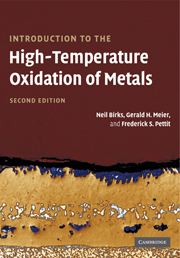Book contents
- Frontmatter
- Contents
- Acknowledgements
- Preface
- Introduction
- 1 Methods of investigation
- 2 Thermodynamic fundamentals
- 3 Mechanisms of oxidation
- 4 Oxidation of pure metals
- 5 Oxidation of alloys
- 6 Oxidation in oxidants other than oxygen
- 7 Reactions of metals in mixed environments
- 8 Hot corrosion
- 9 Erosion–corrosion of metals in oxidizing atmospheres
- 10 Protective coatings
- 11 Atmosphere control for the protection of metals during production processes
- Appendix A Solution to Fick's second law for a semi-infinite solid
- Appendix B Rigorous derivation of the kinetics of internal oxidation
- Appendix C Effects of impurities on oxide defect structures
- Index
- References
11 - Atmosphere control for the protection of metals during production processes
Published online by Cambridge University Press: 05 June 2012
- Frontmatter
- Contents
- Acknowledgements
- Preface
- Introduction
- 1 Methods of investigation
- 2 Thermodynamic fundamentals
- 3 Mechanisms of oxidation
- 4 Oxidation of pure metals
- 5 Oxidation of alloys
- 6 Oxidation in oxidants other than oxygen
- 7 Reactions of metals in mixed environments
- 8 Hot corrosion
- 9 Erosion–corrosion of metals in oxidizing atmospheres
- 10 Protective coatings
- 11 Atmosphere control for the protection of metals during production processes
- Appendix A Solution to Fick's second law for a semi-infinite solid
- Appendix B Rigorous derivation of the kinetics of internal oxidation
- Appendix C Effects of impurities on oxide defect structures
- Index
- References
Summary
Introduction
The exposure of metals to gases at high temperatures during production processes may be divided broadly under two headings.
(1) Reheating for subsequent working or shaping.
(2) Reheating for final heat treatment, sometimes of finished components.
When reheating for subsequent working or shaping, the main concern is to heat the components as quickly and economically as possible to the working temperature, within the metallurgical constraint of avoiding element redistribution and thermal cracking. In addition, it is usual to expose the metal directly to a burned-fuel atmosphere containing about 1% excess oxygen necessary to ensure complete combustion and, therefore, the most economic use of the fuel. Under these conditions, as there is little likelihood of operating a controlled-atmosphere policy, surface damage due to oxidation or scaling and, in the case of steels, decarburization, must be removed at a later stage in the process. Indeed, if the surface of the material to be reheated already has some undesirable features, it may be possible to remove, or reduce, them by allowing some scaling to occur.
Alloys which are susceptible to surface deterioration during reheating may be protected either by controlling the atmosphere composition to minimize, or avoid, surface deterioration or by applying a coating to protect the alloy from the atmosphere.
Coatings are not an economic proposition in the treatment of large tonnage production in this way, but are applied to cause selective carburization, etc., during surface-hardening procedures.
- Type
- Chapter
- Information
- Introduction to the High Temperature Oxidation of Metals , pp. 306 - 322Publisher: Cambridge University PressPrint publication year: 2006
References
- 2
- Cited by



